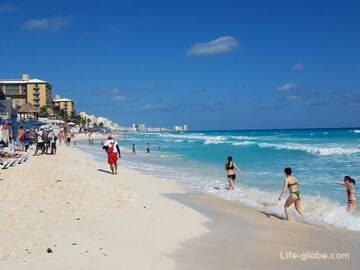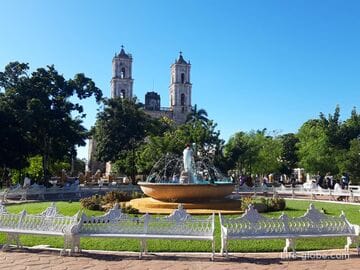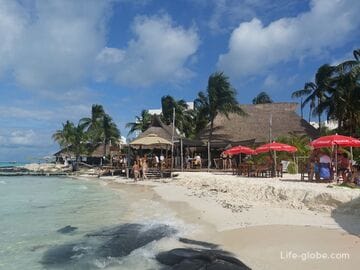Chichen Itza - archaeological excavations of the ruins of the ancient Mayan city, which are recognized as one of the new seven wonders of the world.
In the Mayan languages, the name "Chichen Itza" means "At the mouth of the well of Itza", "Mouth of the well of water sorcerers" or "City of water sorcerers".
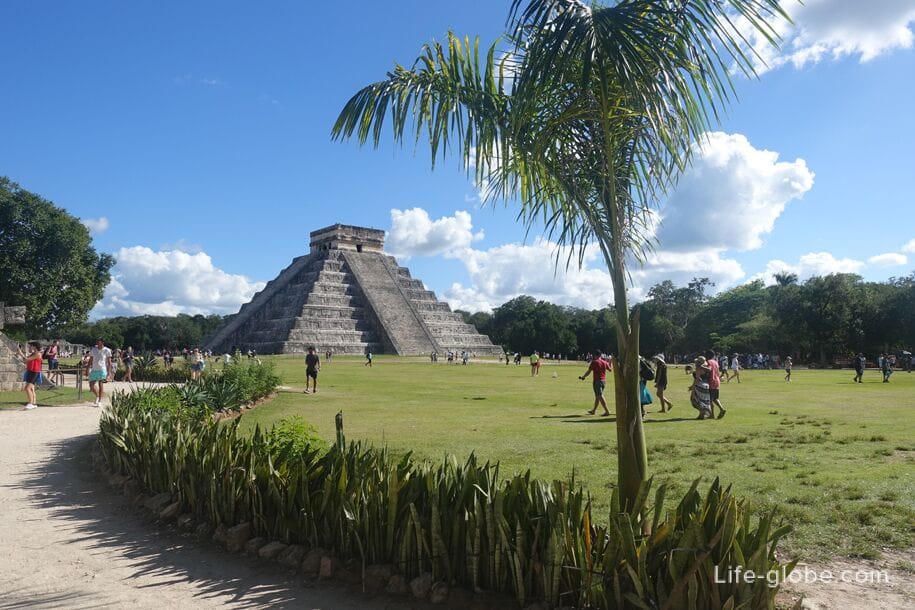
Most likely, the city was founded around 455, which refers to the classic period of Maya development.
Subsequently, the city developed and was the main regional capital, centralizing and dominating the political, socio-cultural, economic and ideological life of the northern Maya.
Thus, the first buildings of the city, dating from the 6th-7th centuries AD, belong to the period of Maya culture, and the subsequent ones belong to the Toltec period, 10th-11th centuries.
Today, Chichen Itza is one of the most impressive ancient cities of the Mayan culture, which is located on the Yucatan Peninsula and ranks second in tourist popularity in Mexico, behind the ancient city of Teotihuacan.
Modern Chichen Itza is a fairly large open-air archaeological area with the ruins of an ancient city, which have been partially restored.
Entrance to the territory of the archaeological zone is paid. Practical information is given at the end of this article.
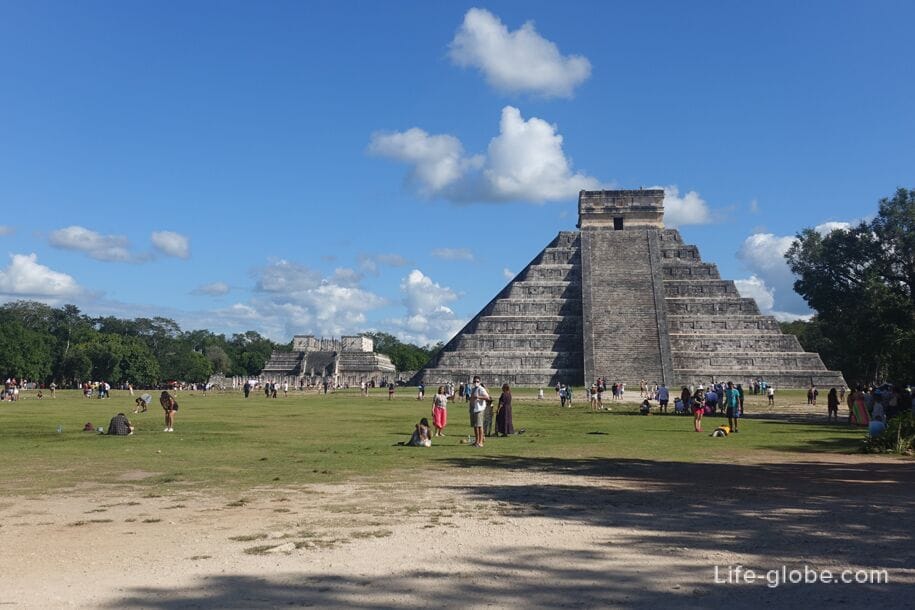
In addition to archaeological sites, cenotes and tourist infrastructure are also located on the territory of the ruins: souvenirs, tents with drinks and snacks, toilets and cafes.
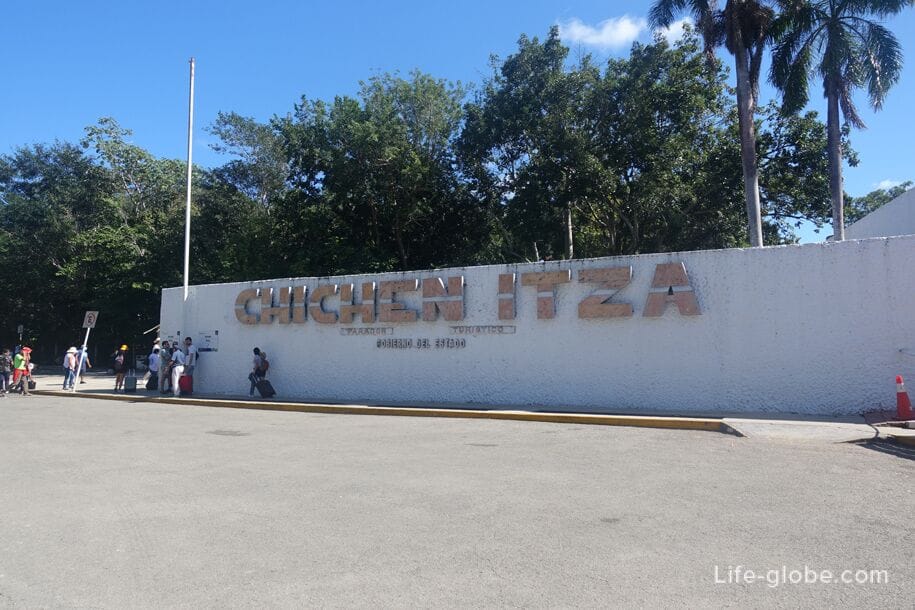
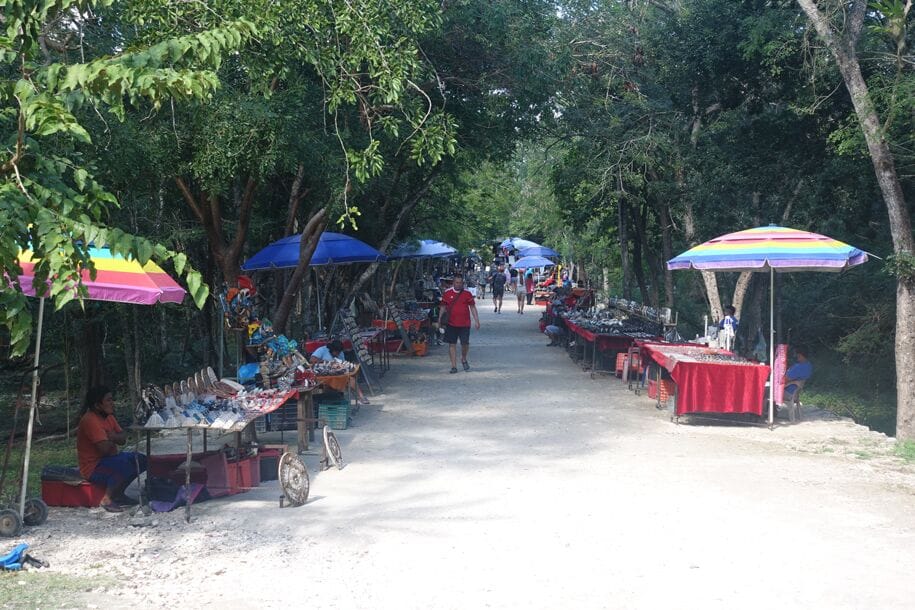
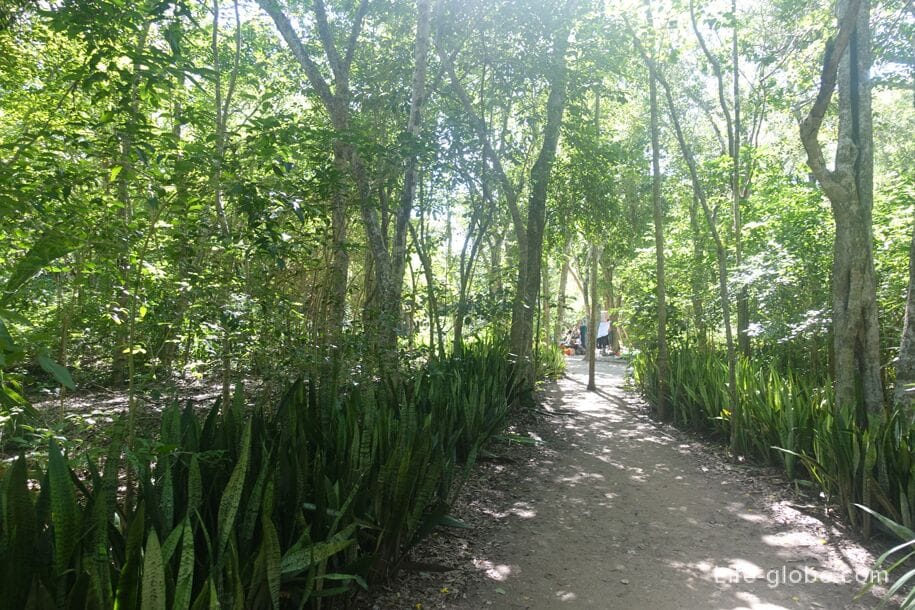


Objects on the territory of the Chichen Itza Archaeological Park
Kukulkan Pyramid
The main and most famous object on the territory of the Chichen Itza complex is the Kukulkan pyramid or the Kukulkan Temple (Piramide de Kukulkan), which is a 4-sided 9-step pyramid with a height of 24 meters with wide stairs on each side and a rectangular temple with four entrances, located at the top of the pyramid.
The main facade of the entrance to the temple has two columns depicting snakes with open mouths. The main entrance is crowned with a large mask of the god Chaak - the Mayan god of rain and lightning.
Kukulkan among the Maya was an analogue of the god Quetzalcoatl.
The Kukulkan Pyramid is one of the tallest and most notable examples of Maya architecture. It is forbidden to climb the pyramid.
The phenomenon of "light and shadow" is interesting in the pyramid of Kukulkan. Evidence of the amazing progress of the Maya in architecture and astronomy is the phenomenon of "light and shadow", which occurs on the northern staircase during the vernal equinox on March 21 and the autumnal equinox on September 21. Around three o'clock in the afternoon on the days of the equinox, the sun projects seven triangles of light onto the balustrade on the northeast side of the pyramid. The shadow begins to move up and down the balustrade, forming the silhouette of a snake.

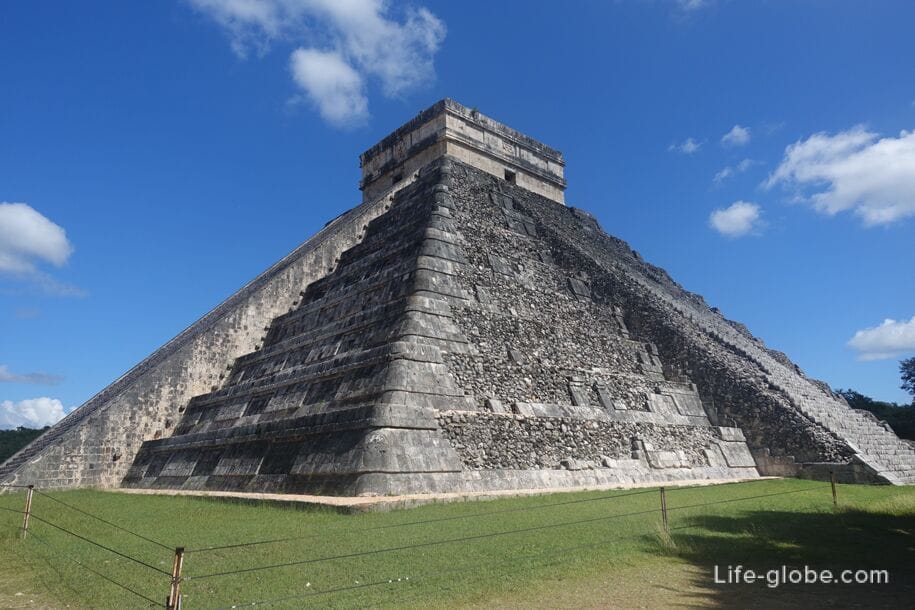
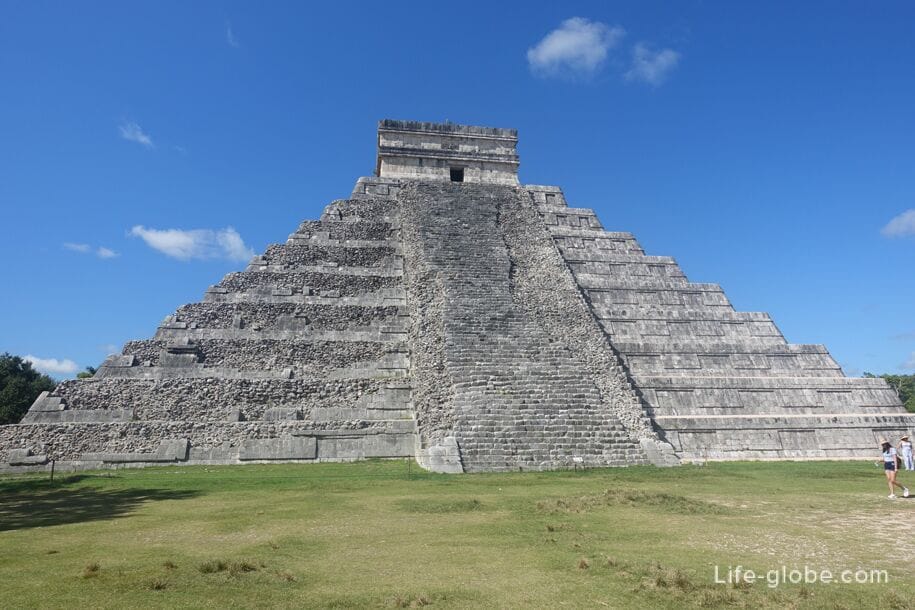
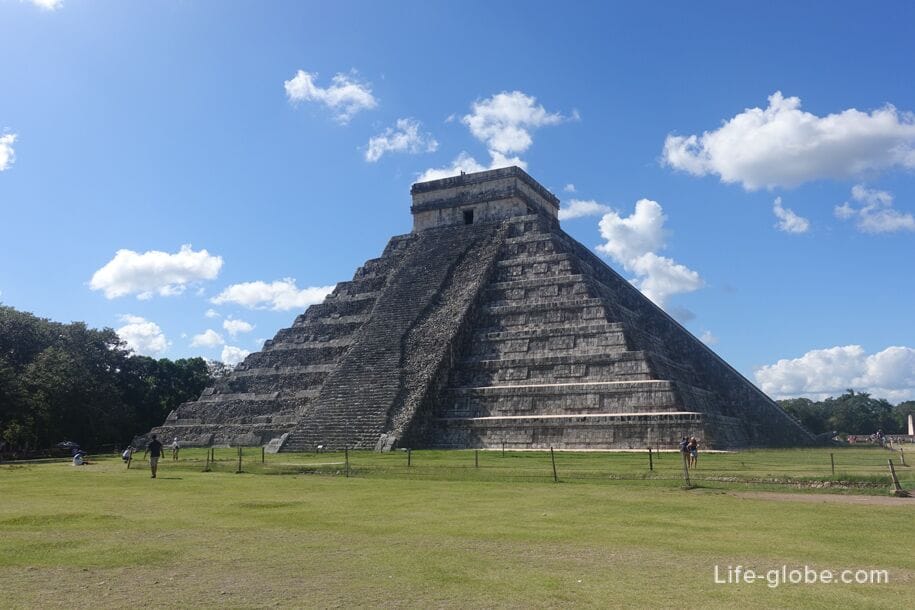
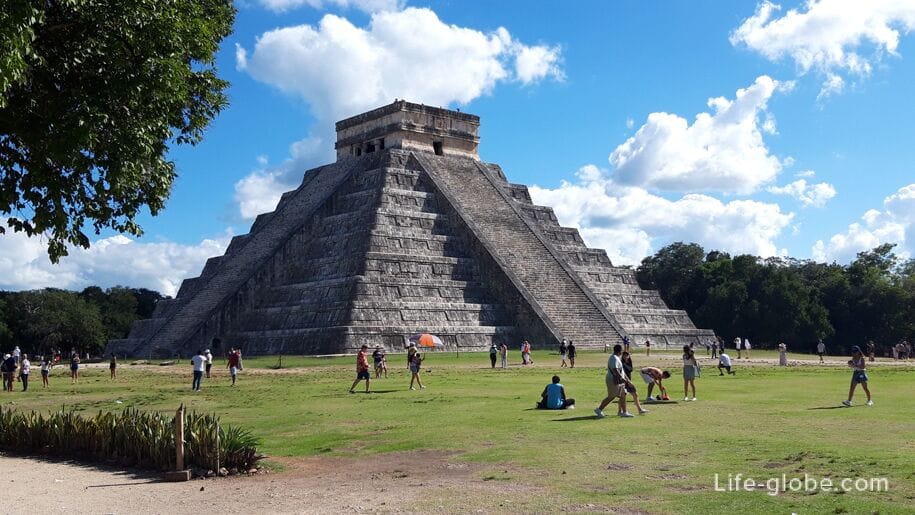
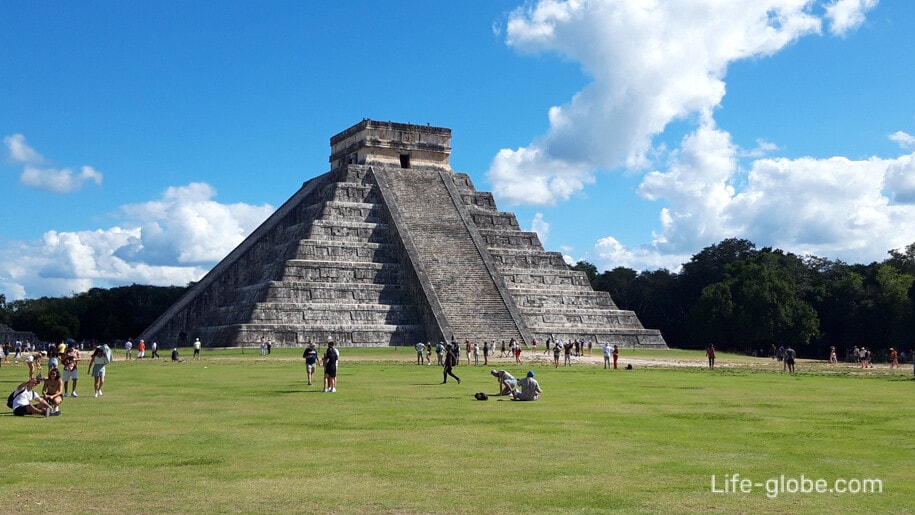
Ball court with temples
Playground (stadium) for the Ball Game, which of all the discovered sites in Chichen Itza (of which there are only 13) is the largest.
The dimensions of the site are 168 by 70 meters (551 by 230 feet). The platform is surrounded on both sides by platform walls, each of which has a length of 95 meters (312 feet) and a height of 8 meters (26 feet). Rings are installed high in the center of each of these walls.
The ball game was characteristic of Mesoamerican societies. Back then, the ball game was more of a ceremonial ritual than a sport, and probably represented a symbolic recreation of the mythical battle between day and night.
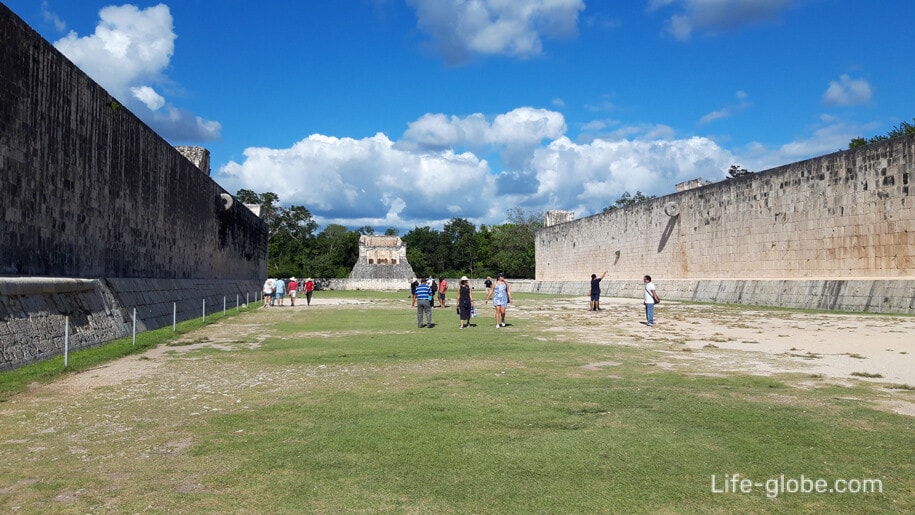
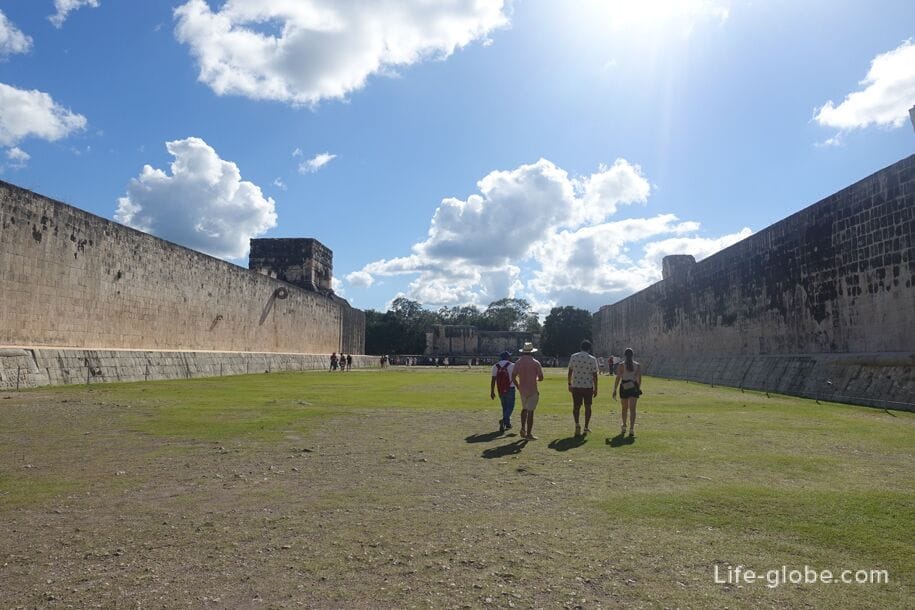
The Temple of the Jaguars is built into the eastern wall of the ball court, the entrance to which has columns in the form of snake heads, and inside of which there is a large, heavily destroyed fresco depicting a battle scene.
At the entrance to the lower tier of the Jaguar Temple, which opens behind the ball court, there is another Jaguar throne.
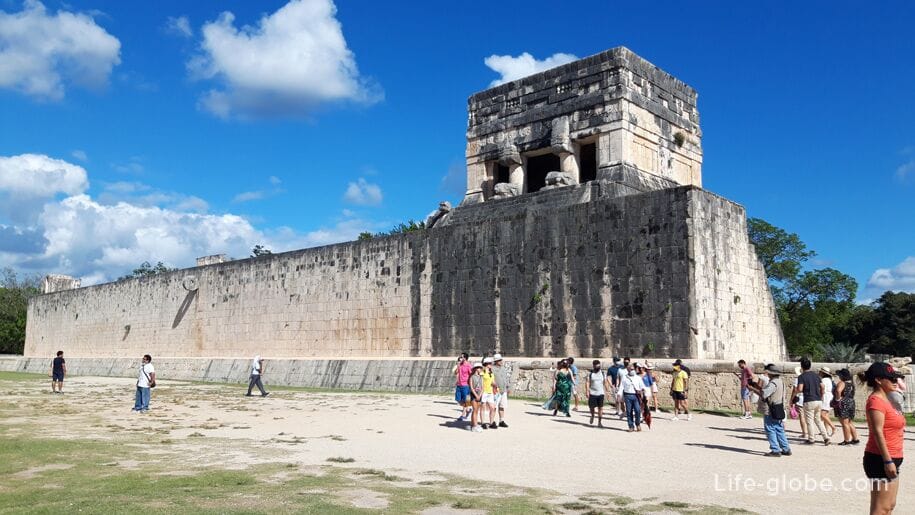

At the end of the ball court is the Northern Temple, also known as the Temple of the Bearded Man (Templo del Hombre Barbado).
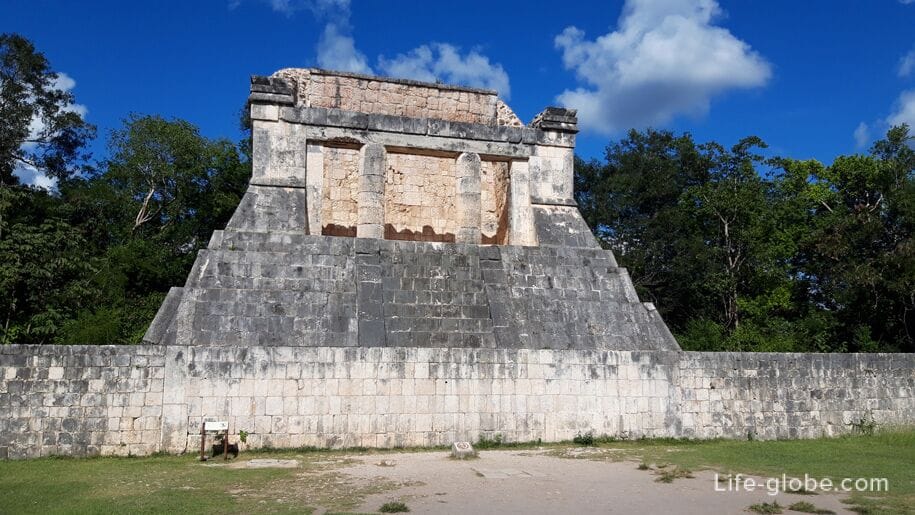
At the opposite (southern) end of the site is another temple of much larger size, but now in ruins.

Tsompantli
Tzompantli or platform of skulls, is a large platform, the most notable details of which are the combinations of skulls on the bas-relief decor, which gave the structure the name "Platform of Skulls".
This monument is the most striking evidence in Chichen Itza of the practice of human sacrifices performed by rulers for religious and military purposes.
Reliefs of four different objects are carved on the walls of the Tsompantli platform. The main subject is the skull stand itself; others show a scene with a human sacrifice; eagles devouring human hearts; and skeletonized warriors with arrows and shields.
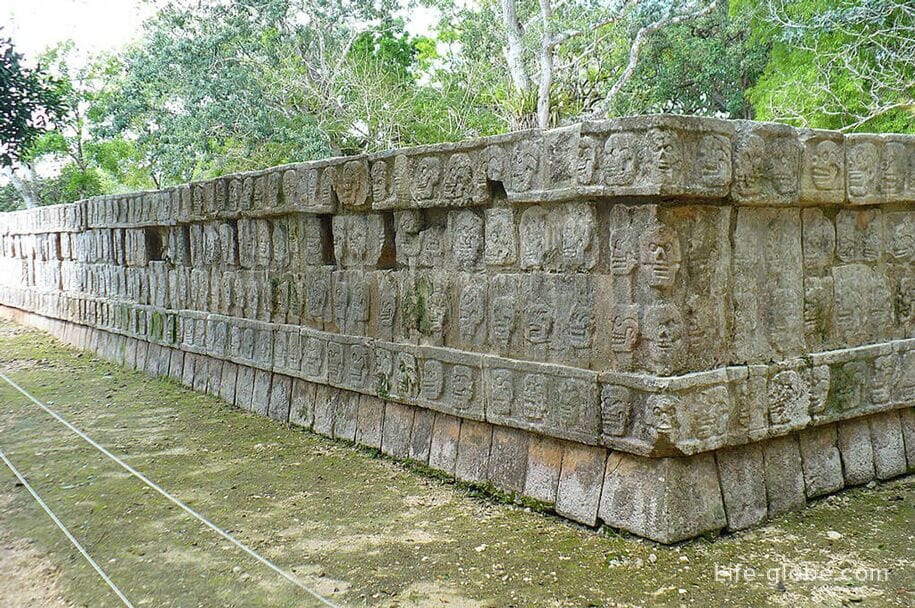
Platform of eagles and jaguars. Venus Platform
These are two square platforms-platforms with stairs located not far from each other.
The eagles and jaguars platform depicts eagles and jaguars, which symbolize warriors who catch victims to feed the sun god. It is believed that the figures of jaguars and eagles devouring hearts represent warriors who were responsible for finding victims for sacrifices to the gods.
The raised panels of the Venus platform depict bas-reliefs of the planet Venus. In the deepened space, Venus is depicted with jaguar claws coming out of the mouth of a feathered snake.
These platforms probably served as podiums for rituals, ceremonies or dances.


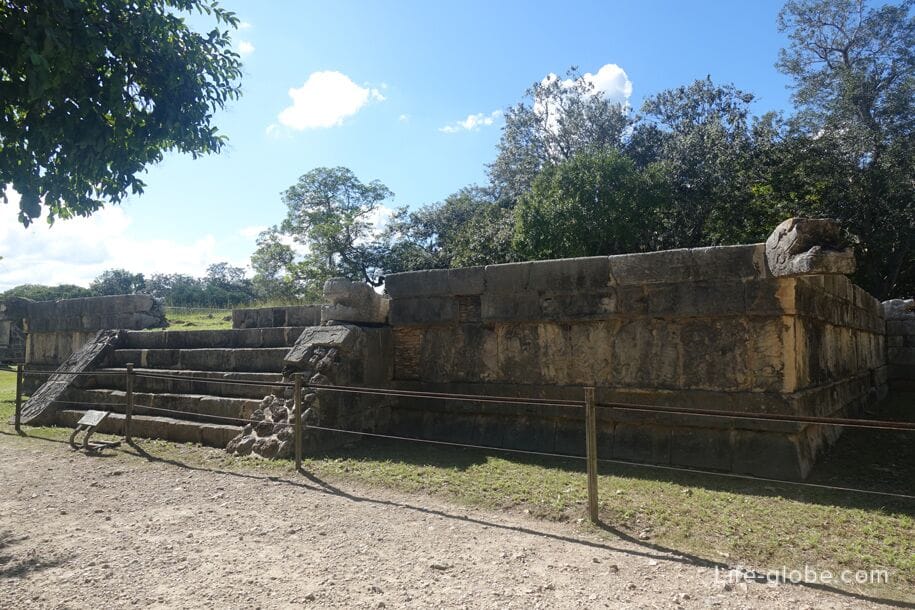
Temple of Warriors
The complex of the Temple of Warriors (Templo de los Guerreros) consists of a large stepped pyramid framed by rows of carved columns depicting warriors.
It is one of the most impressive and important buildings of Chichen Itza and is probably the only large known building of the late Maya classics.
The temple consists of platforms surrounded from the south and west by 200 round and square columns. All square columns with low relief are carved with images of Toltec warriors.
A wide staircase leads to the temple of Warriors with smooth stepped ramps on both sides, where figures of flag bearers holding flags are placed on each ramp. Chakmul was reclining in front of the main entrance.
In the upper part of the temple there are serpentine columns, which had an S-shape. These columns were supported by wooden lintels (now extinct) above the doorways. Astronomical signs and decorative elements on the head of each snake are carved above the eyes.
At the top of each snake's head is a shallow recess that could be used as an oil lamp.

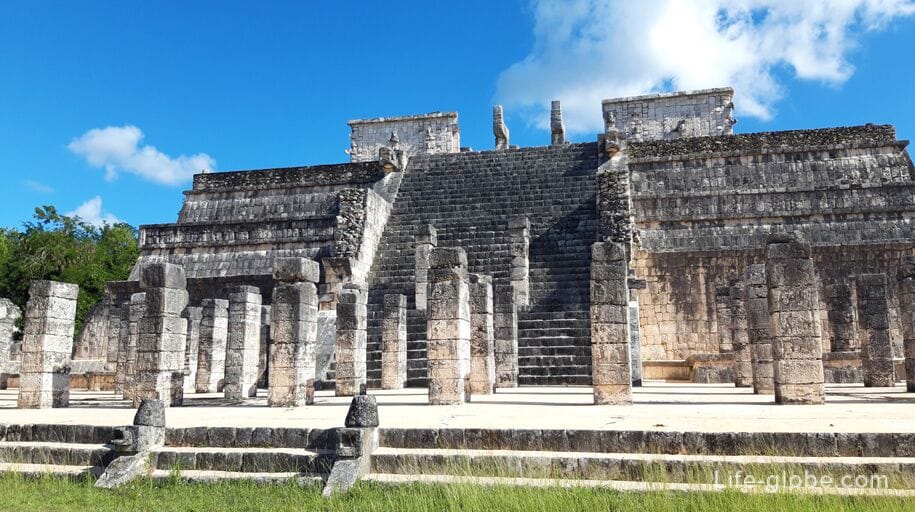
The Temple of Tables
The Temple of the Tables (El Templo de las Mesas) is located to the left of the temple of the Warriors and is a 4-step pyramid with a staircase, which got its name because of the presence of several altars on its upper platform.
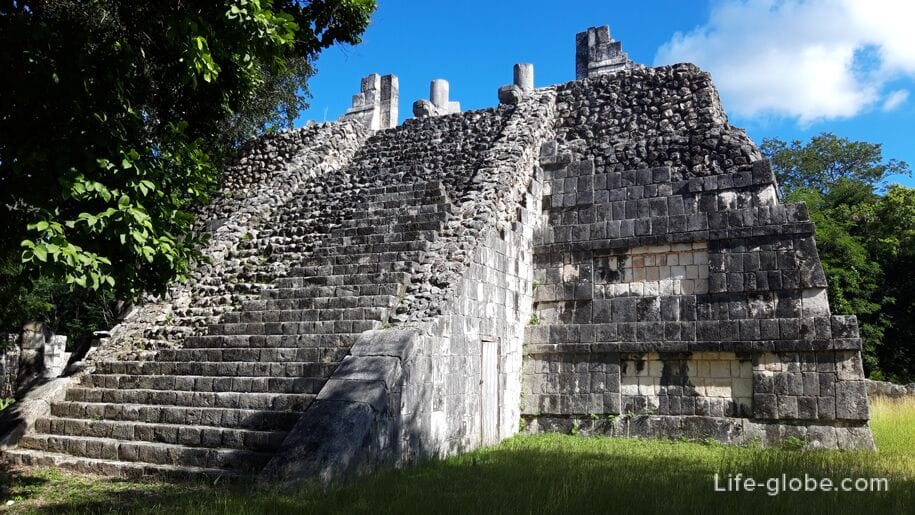
A group of thousands of columns and a Market square
Near the temple of Warriors there is also a group called The Thousand Columns Group, which in reality is much smaller. All the columns once supported the frieze and the roof, which collapsed long ago. The exact nature of the roof is not known - it may have been made of mortar, wood or straw. The premises may have served as conference rooms and other facilities.
Nearby is the former Market Square (The market place), which is located on a large platform; has a central staircase with balustrades and a row of round pillars alternating with square pillars. The pillars supported an arched roof, the widest in the city. The central door led to a square courtyard surrounded by the tallest columns in the area. It has not been proven that this area, which today is called the Market Square, was actually used for trade and commerce.
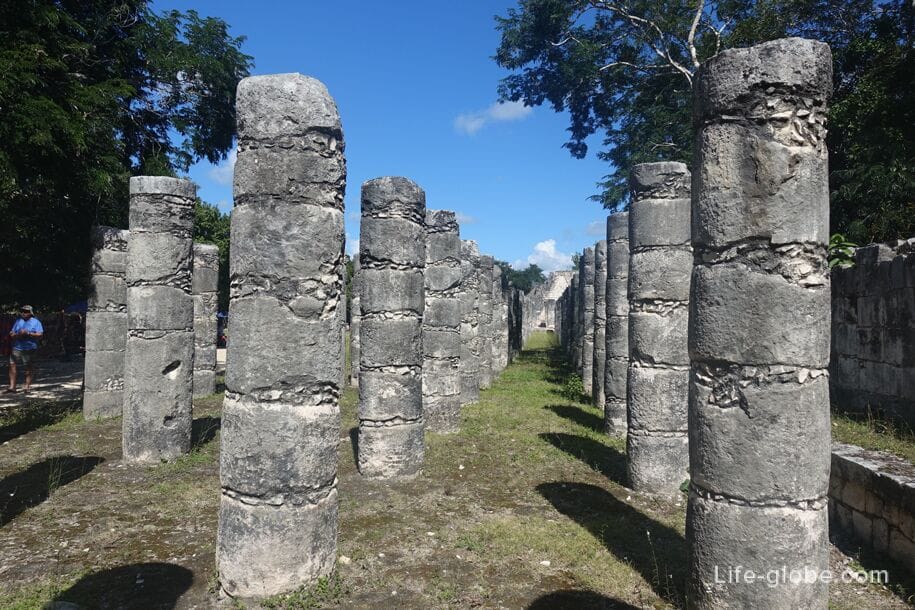


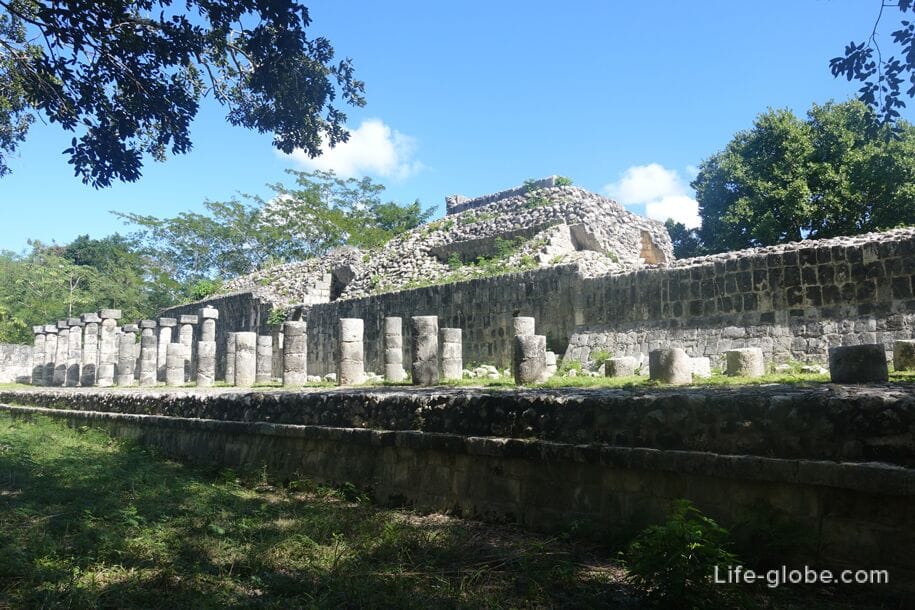
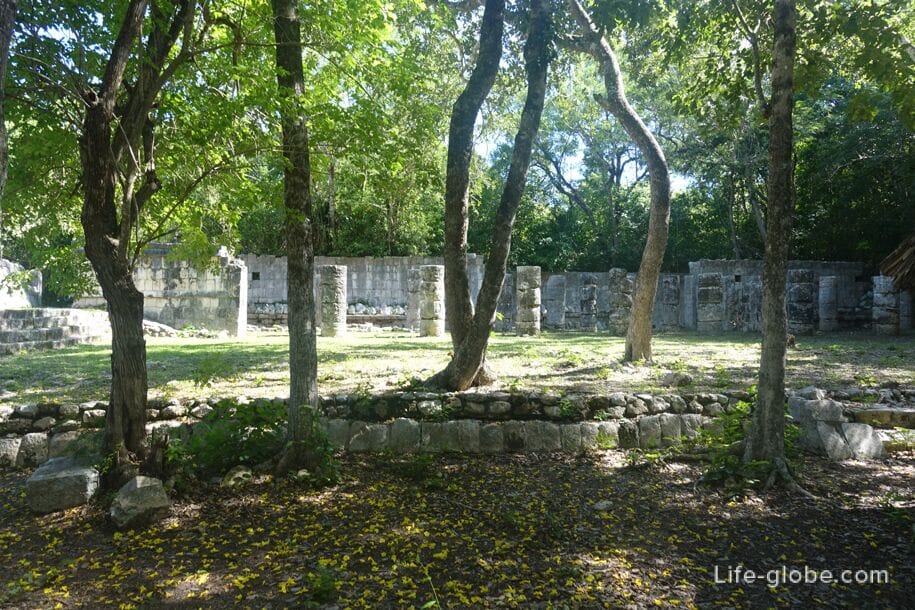
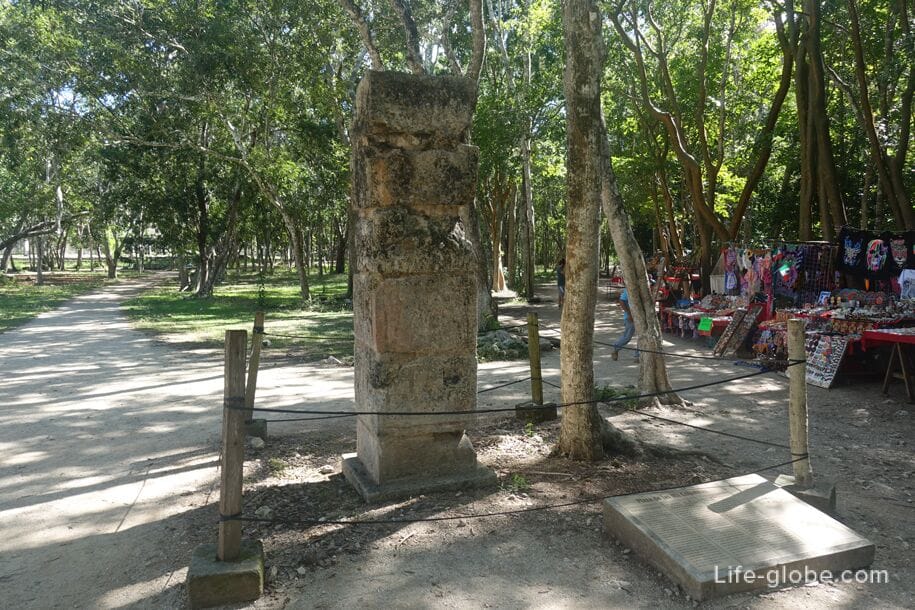
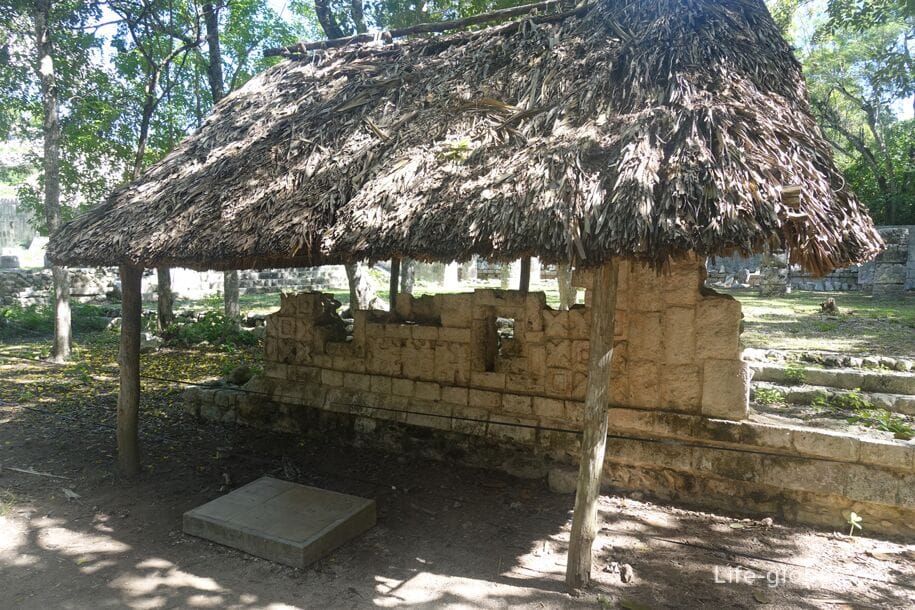
Sacred Cenote
The sacred cenote is a natural open well.
As part of the cult to the god of water, the pre-Hispanic Maya made ceremonial offerings by throwing many precious objects into the well. Later they introduced the custom of offering human sacrifices, which became warriors, children and girls thrown to the bottom of the cenote.
On one side of the southern bank of the well, the Maya built several platforms on two levels, which may have been used as seats for those who witnessed the ceremonies.
Next to the cenote, you can also see the ruins of a building that was adapted for a steam bath (Temazcal), where it is assumed that the victims were cleansed before the offering. Opposite this building is another platform that hangs over the edge of the cenote, from which offerings and sacrifices were most likely made.
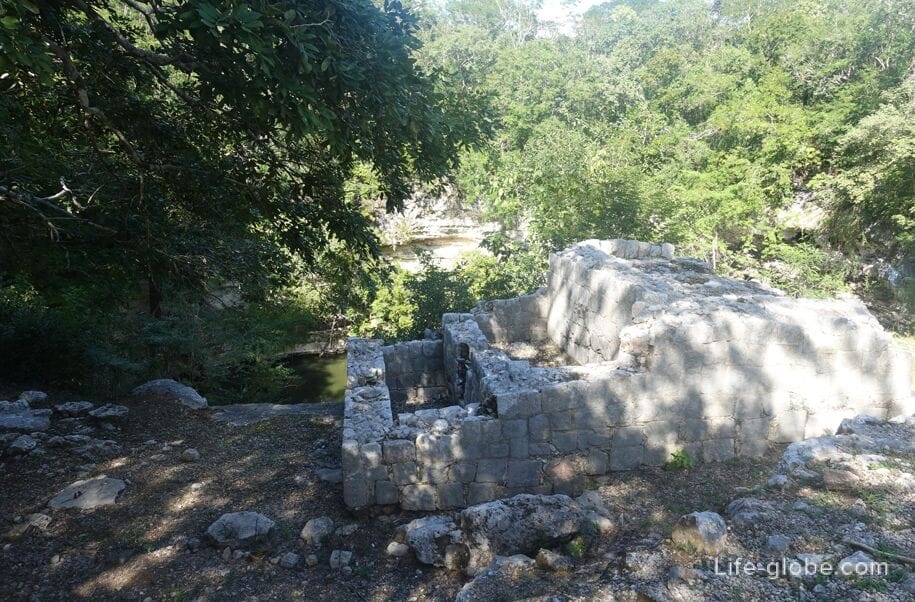
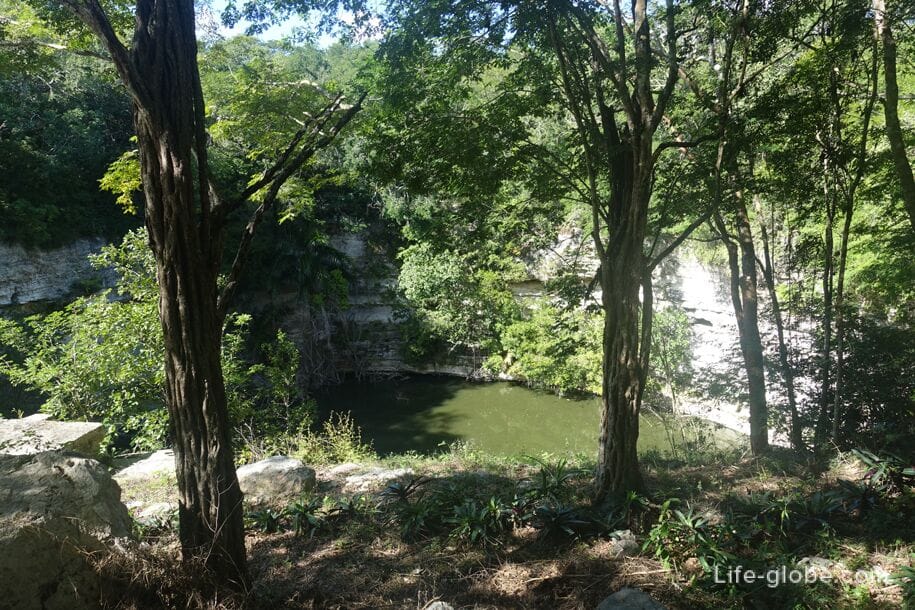
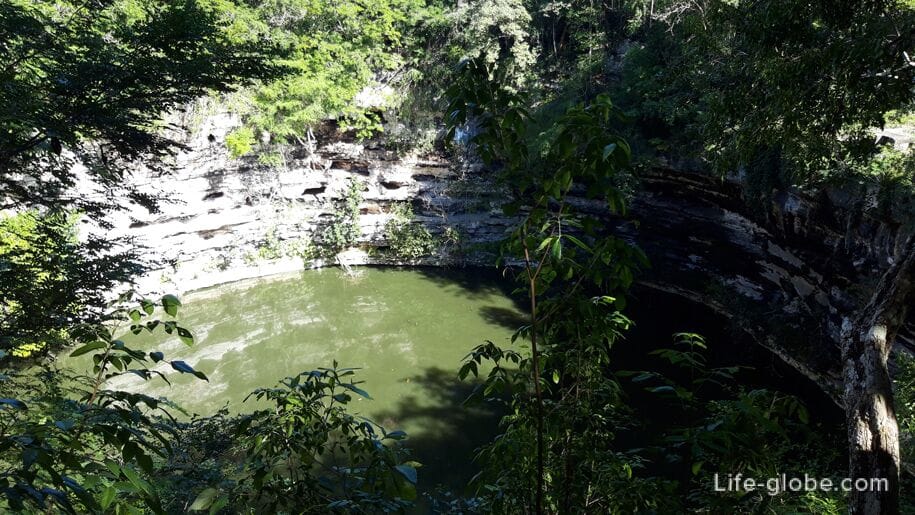
The Temple of the Enlightener
Grave grave of the priest or the tomb of the high priest, also known as the temple of the Enlightener (Osuary / El Osario), is a pyramid with nine stepped blocks and a staircase on each side. Stairs with balustrades carved from intertwining snakes lead to the temple at the top, at the entrance to which two serpentine columns are visible.
The temple was built over a deep cave, into which one could descend through an entrance made in the floor of the upper temple. At the entrance to the cave there are seven tombs in which there were offerings of jade, rock crystal, shells and copper.
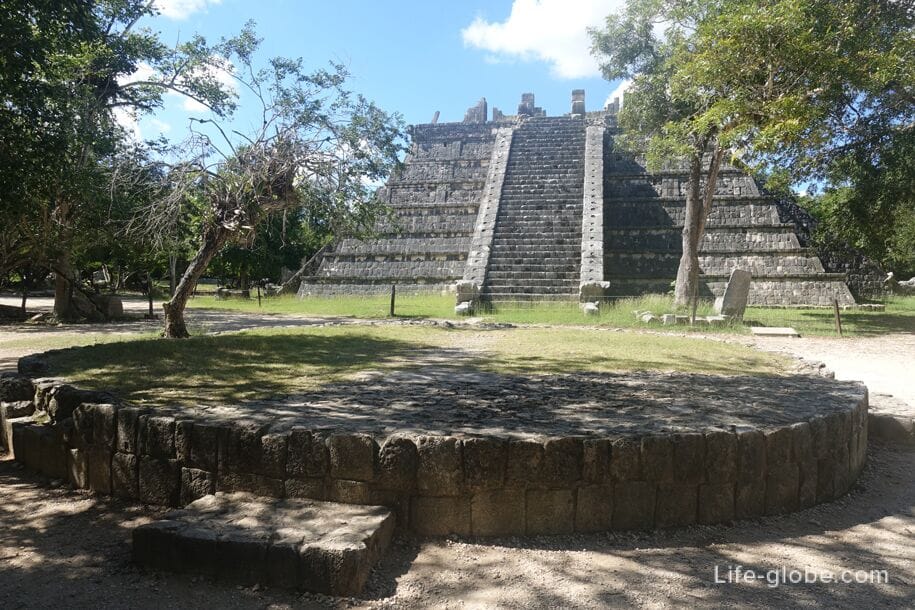
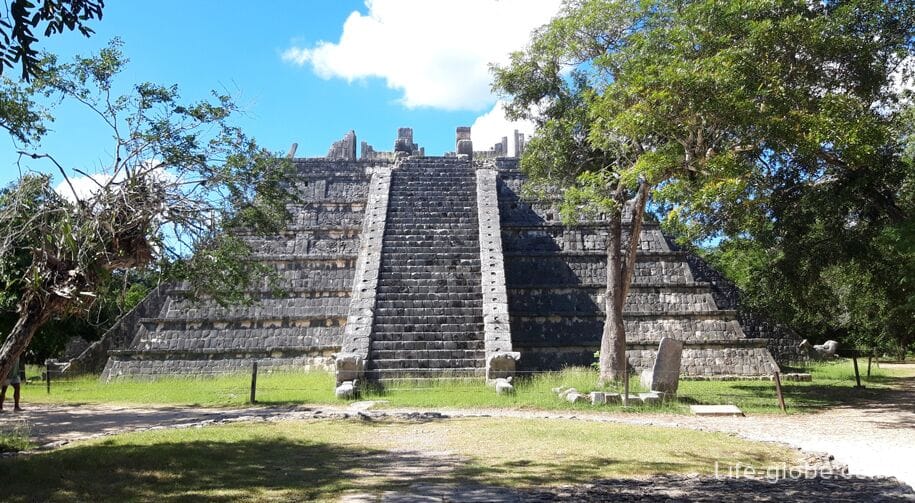
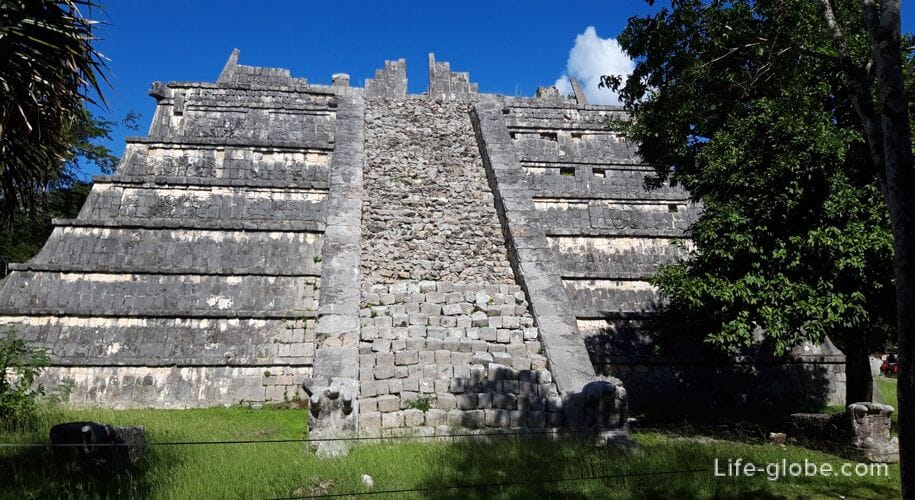
There is a ritual platform near Osario.
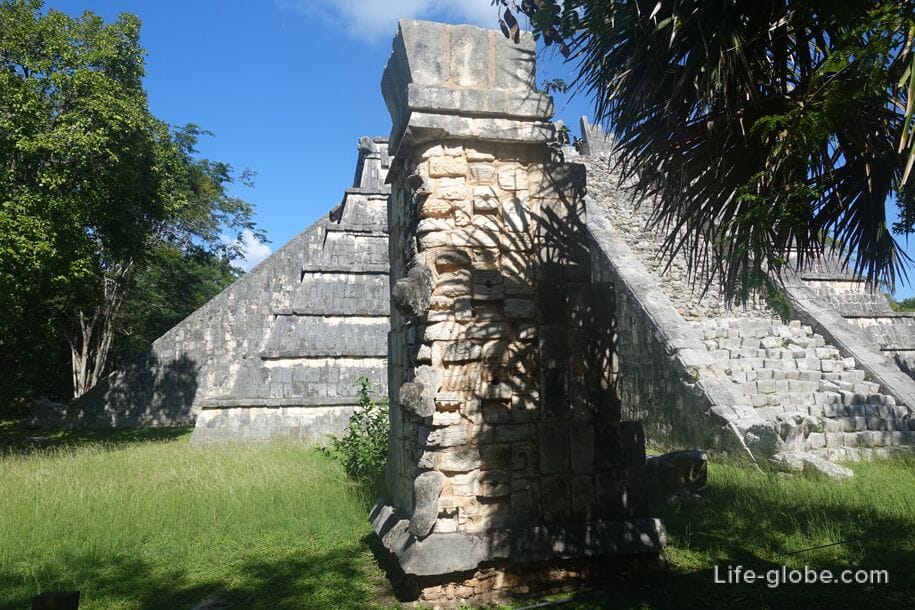
Deer House
The House of the Deer (The House of the Deer) is now badly destroyed. There are almost no remnants of the ridge above the roof.
The name of the building, according to tradition, comes from the image of a deer in the interior, which has now disappeared.
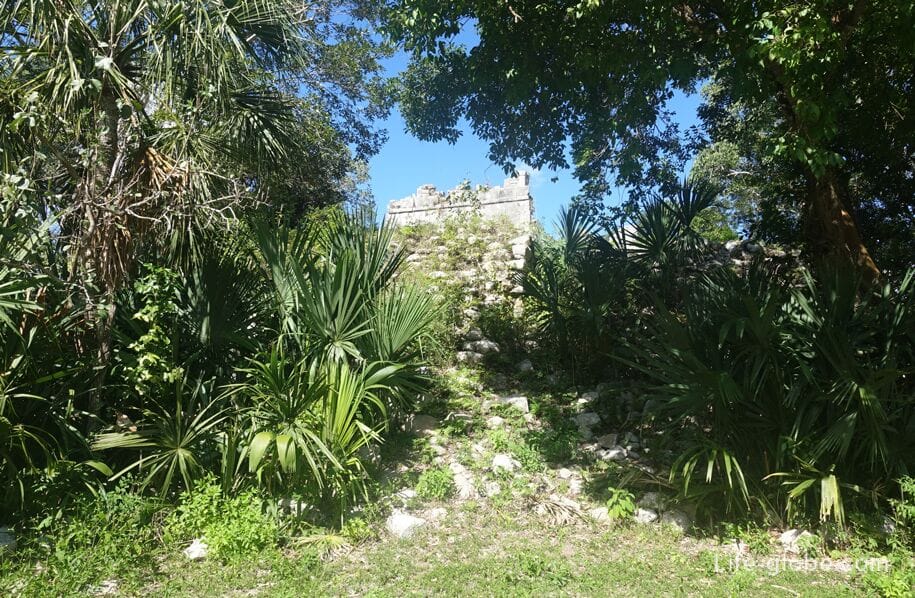
Red House
Chinchanchob or Red House (The Chichanchob or Red House) is installed on a rectangular platform with rounded corners.
A staircase without balustrades provided access to the temple at the top with two ridges, one in front and one in the central part of the roof. The front coat of arms is decorated with alternating patterns of frets and Chaak masks over the entrances. The style of the building corresponds to the style of the Puuk region.
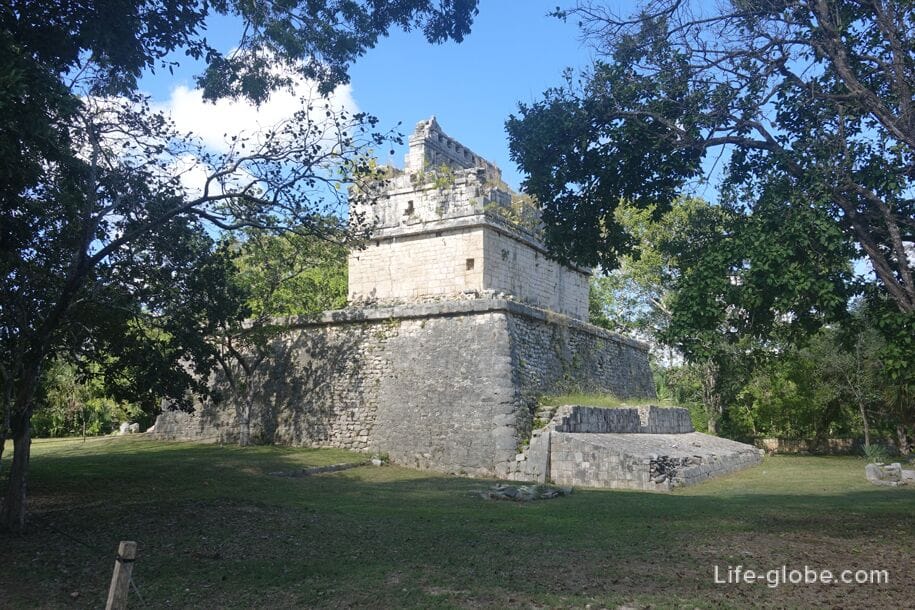

Temple of Carved Boards
Small remains of the temple of Carved Boards (templo de los Tableros Esculpidos).

Karakol Observatory
The Observatory of Caracol (El caracol) is one of the most striking buildings of Chichen Itza.
It is believed that this building was one of the few circular structures built by the Maya, and was used for astronomical observations through holes in the upper part of the tower.
The so-called Karakol or Observatory is a structure built in the form of a large round tower mounted on a platform with a central staircase. The base is installed on another rectangular platform, decorated in the upper part with a cornice with rounded corners.
The whole Karakol is built of three superimposed buildings.
The first part of the cylindrical observatory tower is formed by two concentric walls that surround a pair of circular chambers with four doorways in each.
The second level of the tower consists of a cornice of the first level and a second, narrower one framing the frieze. Above the doors, the frieze depicts a Chaak mask and a seated figure framed by an ornament of feathers and snakes.
The third and fourth parts of the tower have collapsed, but you can still see a number of holes or windows that may have served for astronomical observations.
On the western side of the larger base of the structure is a staircase, the balustrades of which are decorated with intertwining snake heads.
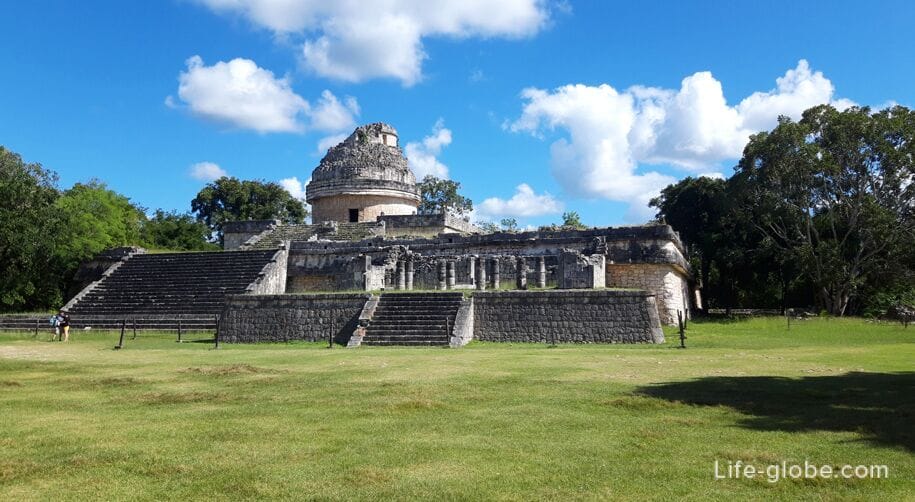



House of Nuns
The House of Nuns or convent (Casa de las Monjas) forms a complex of several buildings and is one of the most impressive architectural ensembles of Chichen Itza.
The main facade of the complex faces north and consists of three buildings: the monastery of the nuns, the eastern and southeastern extensions dating from different periods of construction.
The nuns' house stood on a base that is now no longer visible, the main part of the building has a central staircase on the north side that led to the upper temple. The temple has an ornate facade in the Chenes style.
Due to the large number of rooms separating the upper temples, researchers in the colonial period believed that the building could serve as a monastery for the training of priestesses.
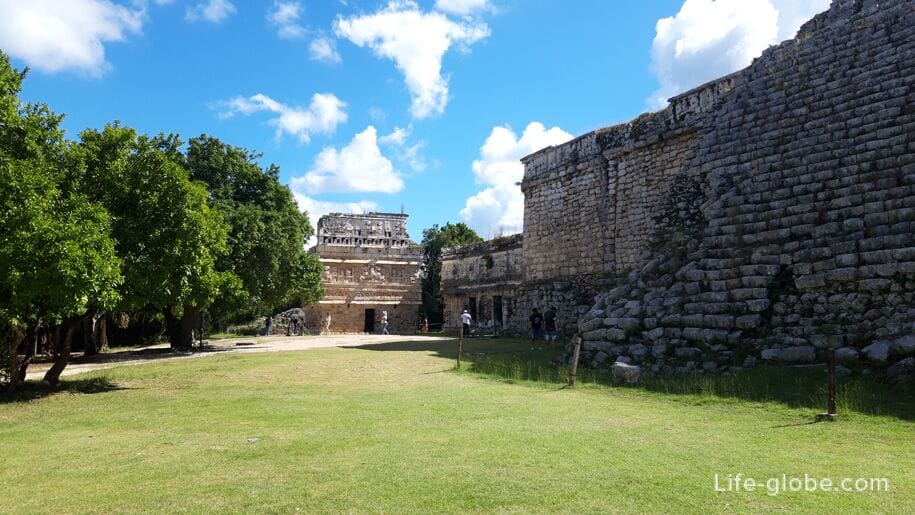
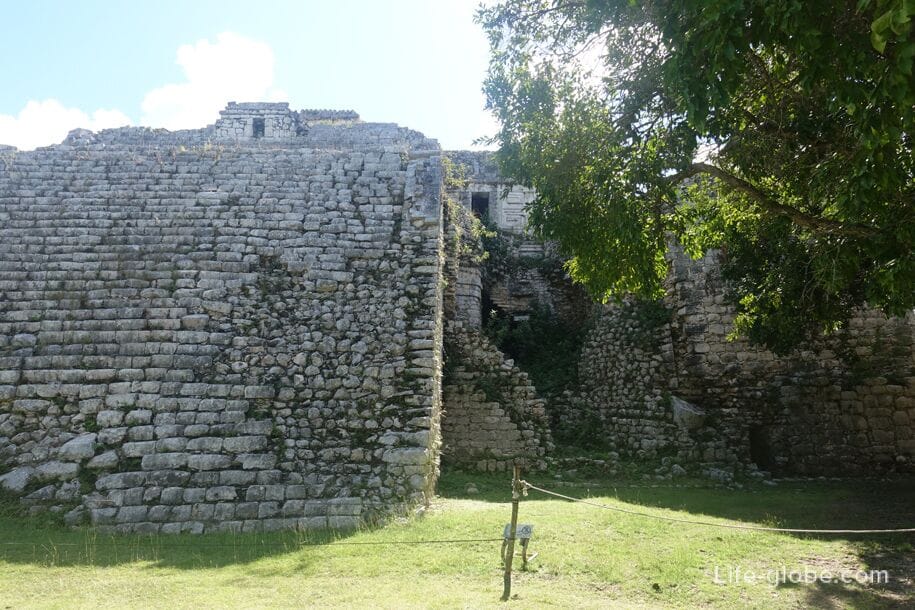
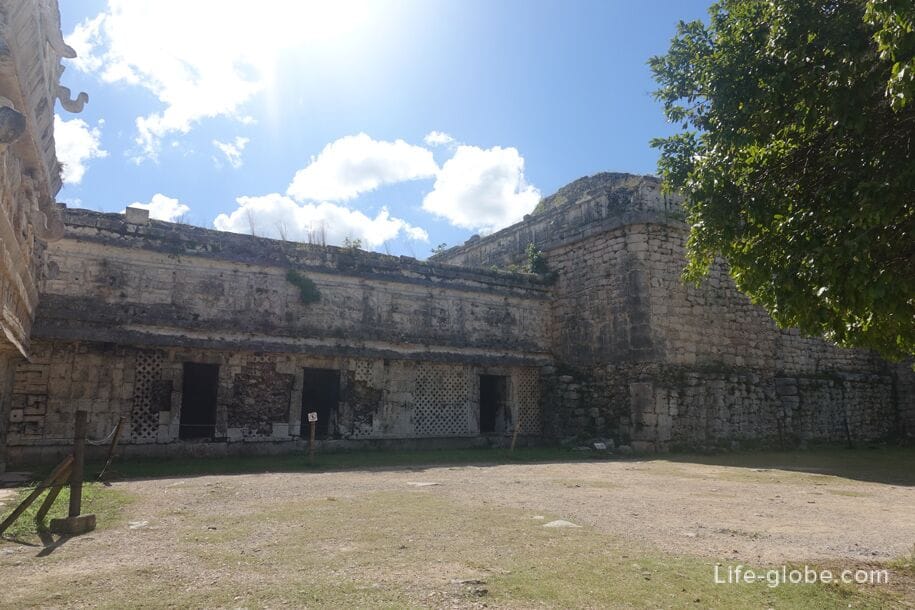


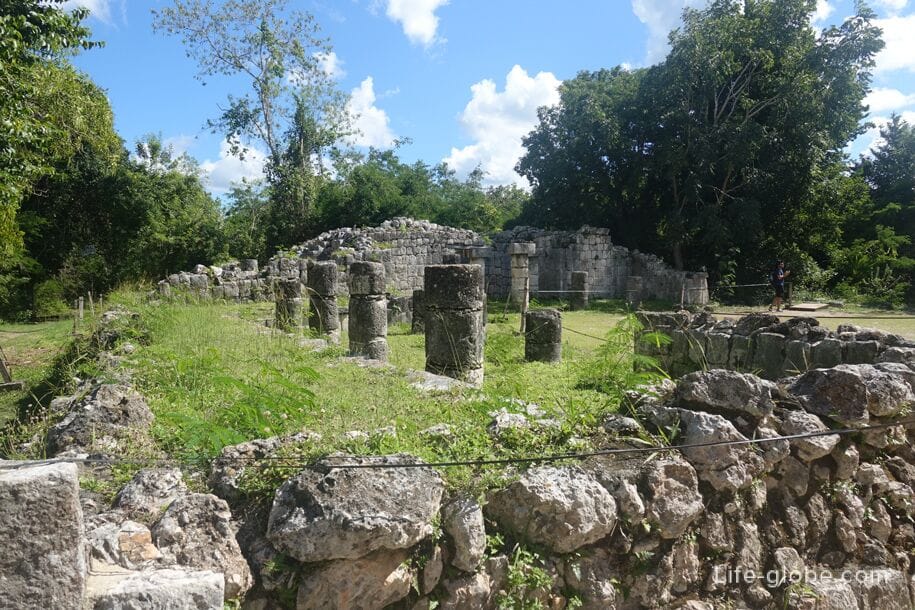
To the left of the tall, heavy structure is a square building called the Church (Iglesia / La Iglesia) with an annex of a convent and a small ball court.

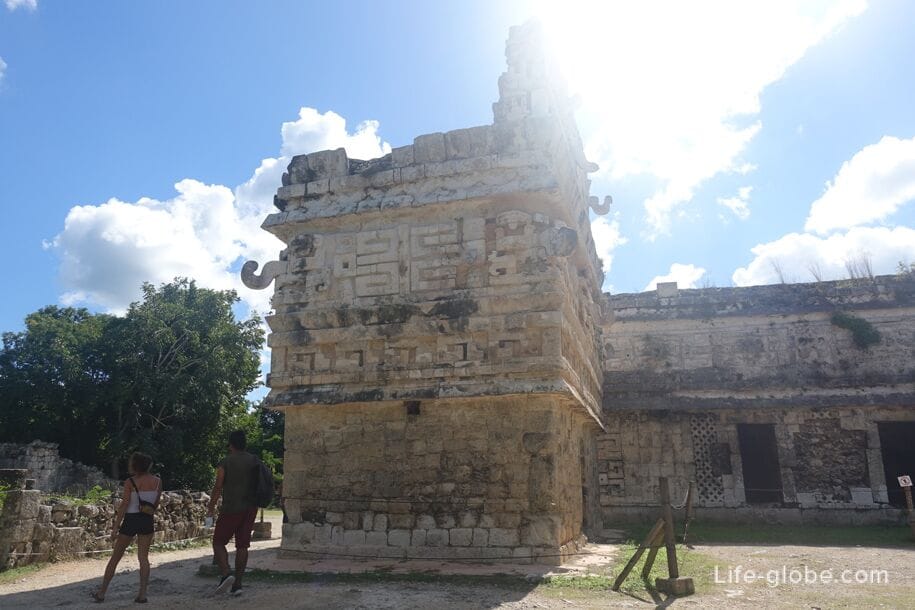

Near the church, a building with a ridge on the roof and ornaments of stone mosaics in the upper and lower parts adjoins the monastery complex. Next comes a frieze with a Chaak mask in the middle. On the sides there are niches with figures of four bakabs or "supporters of the sky", depicted in the form of an armadillo, a sea snail, a turtle and a crab. In the corners on both sides of them are Chaak masks.

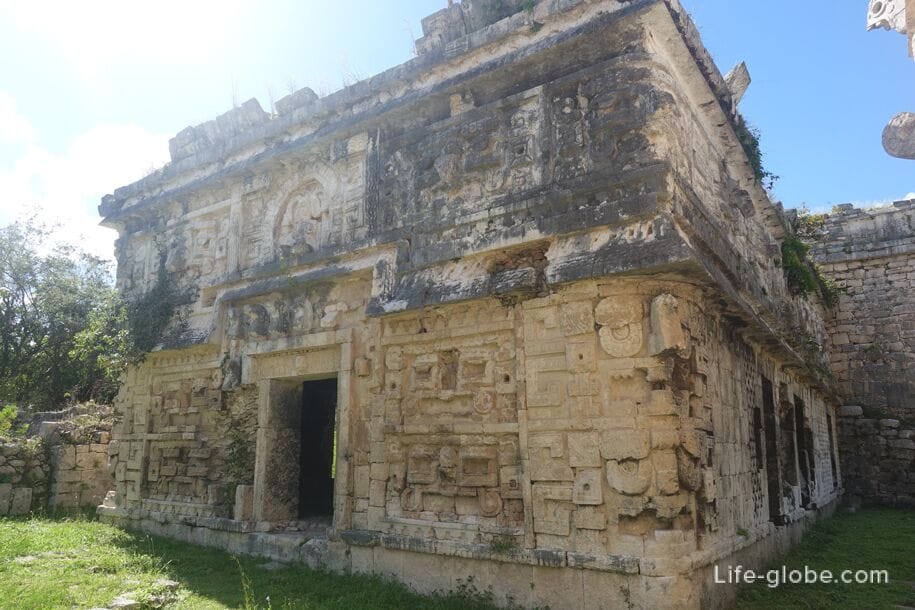
In addition to those listed, there are also other ruins on the territory of the archaeological complex of Chichen Itza, including the Rodont platform, a road, the remains of walls; as well as another cenote - the southern cenote of the Stoloc (Cenote Xtoloc).
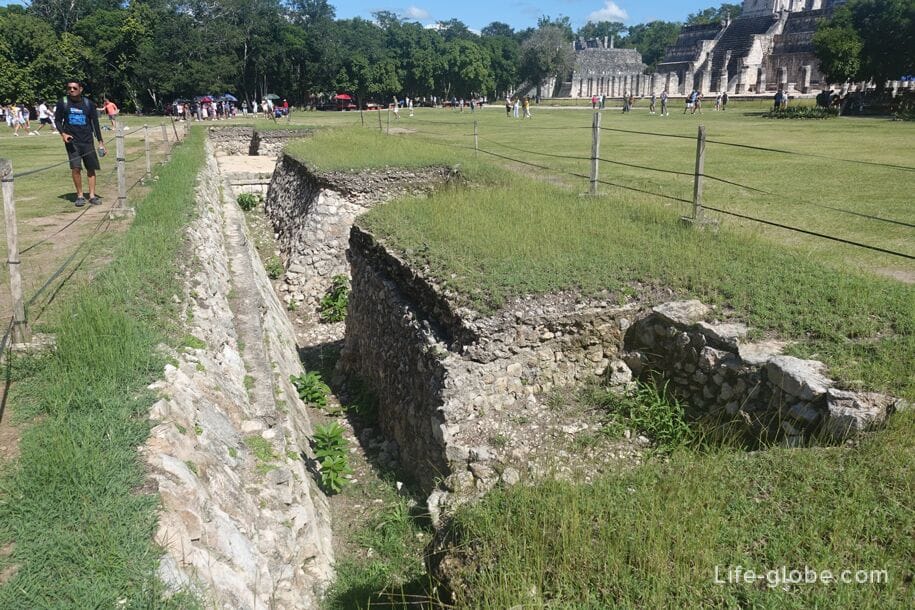

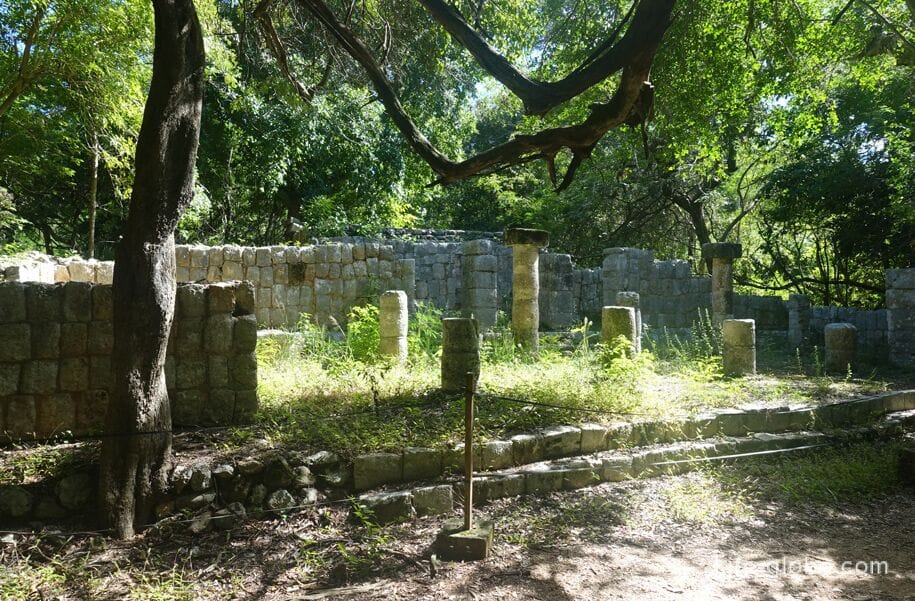
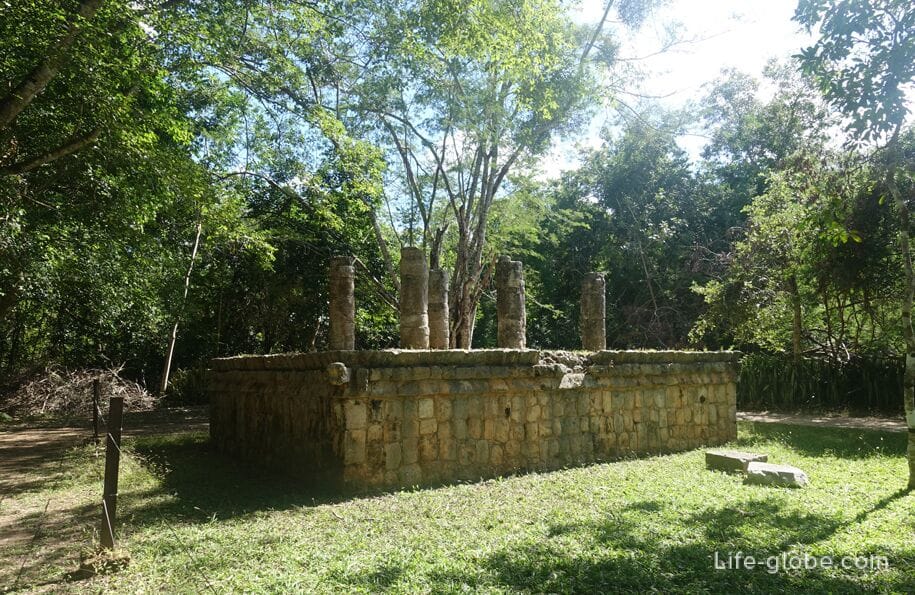
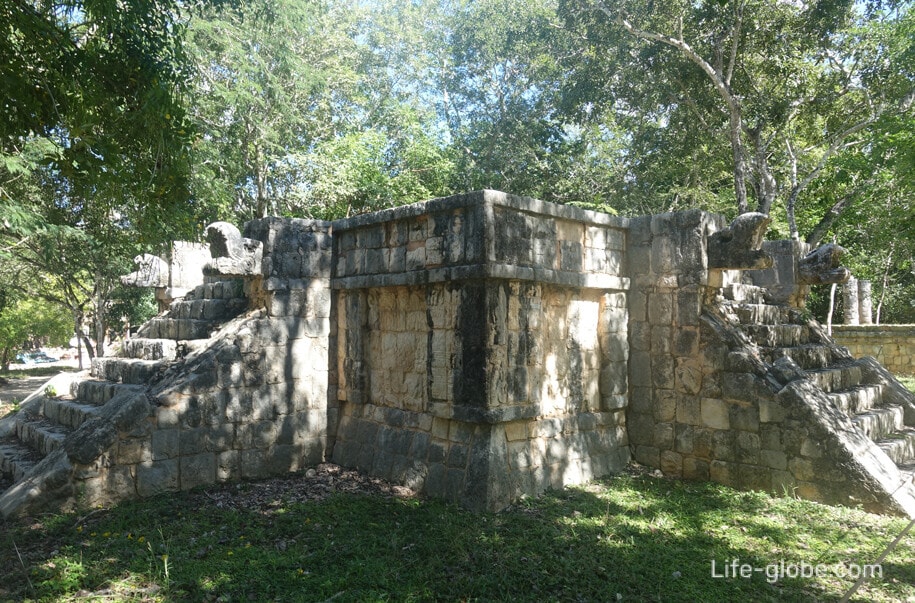
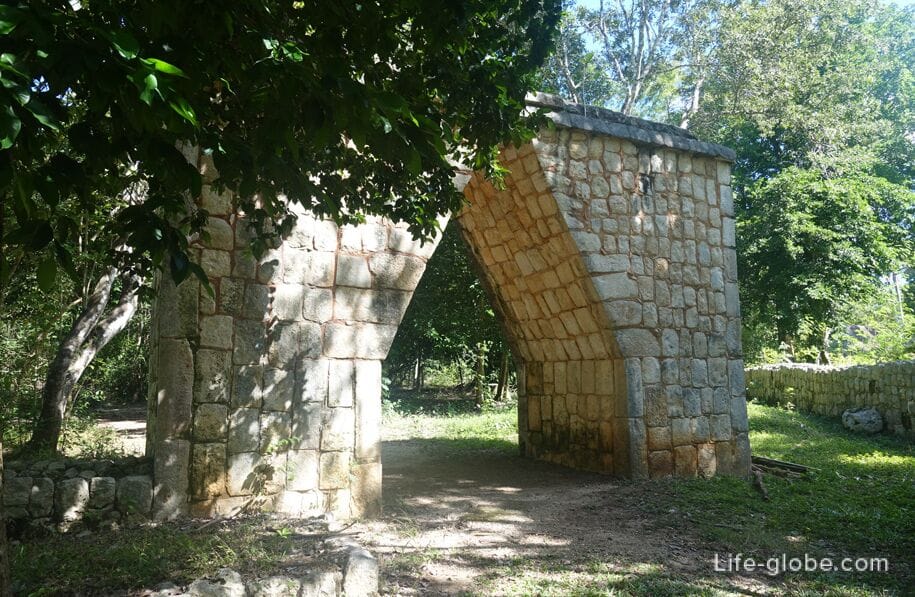


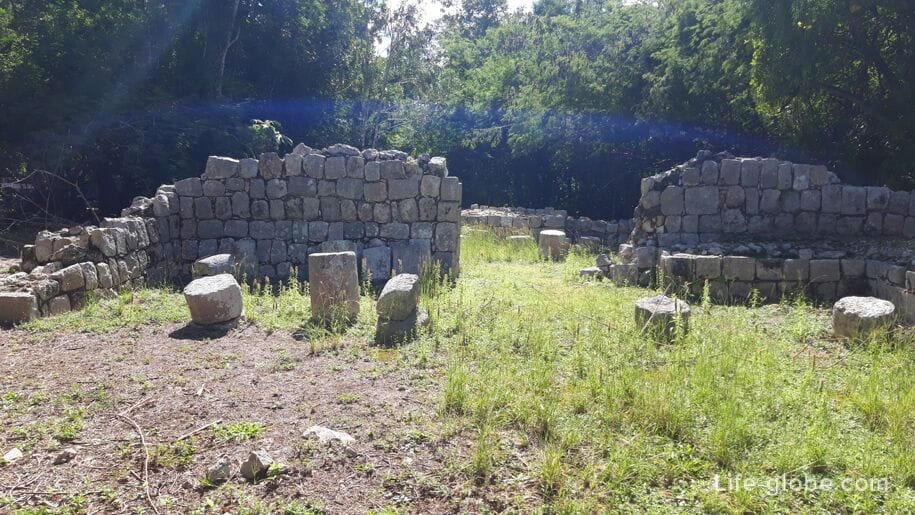


Scheme of the Archaeological Park of Chichen Itza
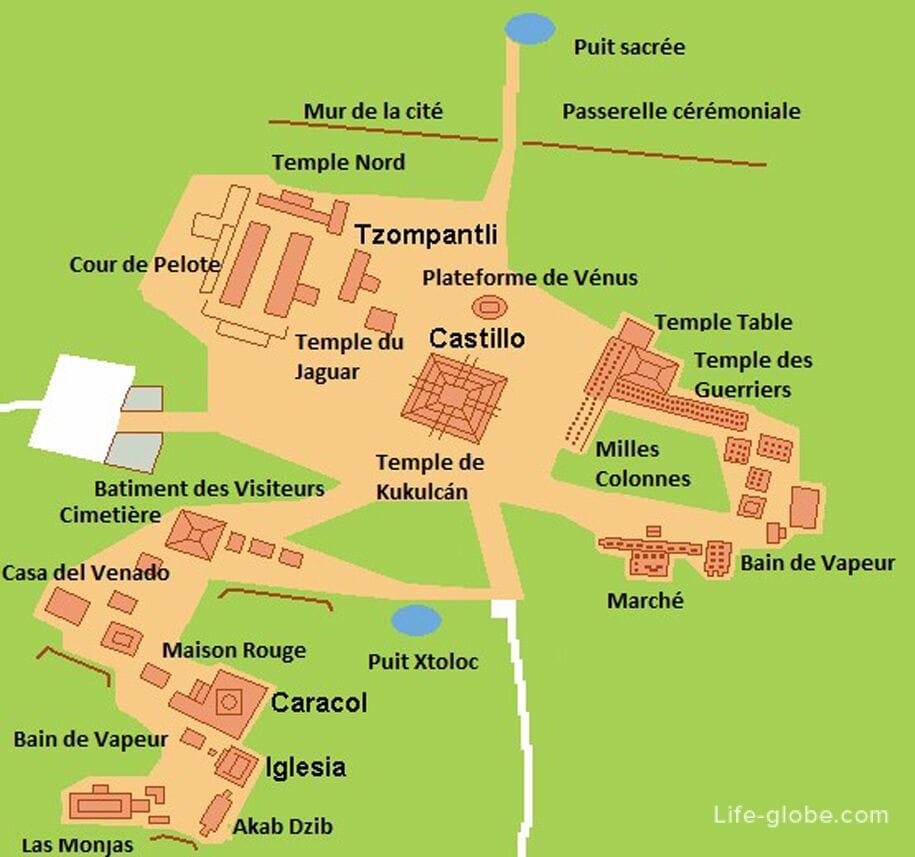
Practical information
The Chichen Itza Archaeological Park is located in the north of the Yucatan Peninsula in Mexico, 120 kilometers east of the city of Merida.
Entrance to Chichen Itza is paid. Tickets can be purchased at the ticket office at the entrance.
Holidays and events are held on the territory of the park.
Chichen Itza Archaeological Park Website: chichenitza.com .
There is a parking lot near the entrance to the park.
You can get to Chichen Itza by public buses, taxi or car.
More information about how to get to Chichen Itza can be found here →
You can visit Chichen Itza with excursions to Yucatan from Cancun, Playa del Carmen and Tulum
Directly near the archaeological zone of the ruins of Chichen Itza, you can stop
5-star Lodge The Lodge at Chichen Itza with swimming pools
5-star Mayaland Hotel & Bungalows with rooms, suites and bungalows
3-star Villas Arqueologicas Chichen Itza
Near the archaeological zone of Chichen Itza is located Cenote Ik Kil, which can be reached in the same ways as to Chichen Itza; and if desired, combine visits to two attractions.
Near the cenote, the Ik-Keel is 3-star Doralba Inn Chichen with outdoor pools.

All accommodation facilities in Mexico, including near Chichen Itza, Cancun, Playa del Carmen, Tulum, Merida, Valladolid, Mexico City, etc., can be viewed and booked here






